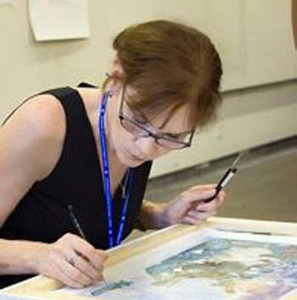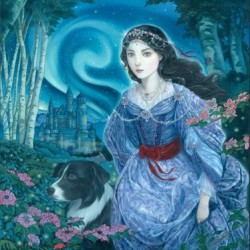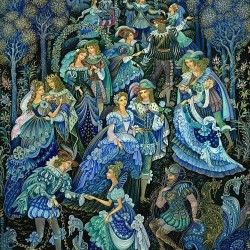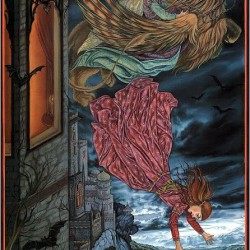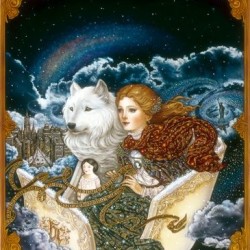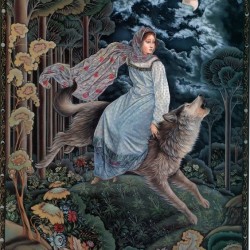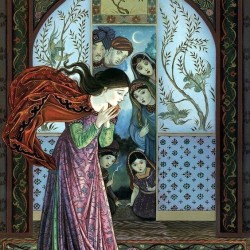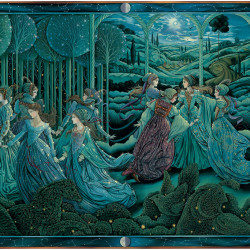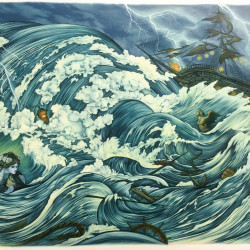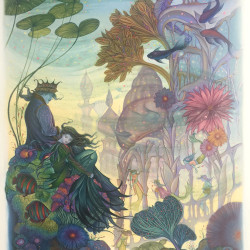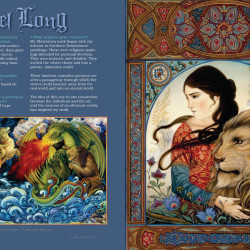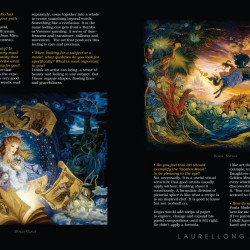Q: Tell us a little about your method and how you came to favor this medium.
A: I paint in oils on a smooth primed surface. I paint opaquely on the first layer, then glaze and detail on two to three more layers. I started painting in oils in middle school I loved everything about oil painting from the start and never stopped.
Q: Do you consider yourself a storyteller, does your art have a message?
A: My paintings are narrative and based on stories and fairy tales.
Q: When you create art is there a particular audience you are trying to reach?
A: No. I just try to do my best, and hope someone likes it.
Q: What inspires your creations?
A: My illustration work began with my interest in Northern Renaissance paintings. These were religious paintings intended for personal devotion. They were intricate and detailed. They invited the viewer closer and into a private, miniature world. These timeless, narrative pictures created a passageway through which the viewer could journey away from the real world and into an eternal world. The idea of this one-to-one connection between the individual and the art, and the creation of an alternate reality has inspired my work.
Q: Is there someone special who has encouraged your work and your path as an artist?
A: Yes. Jan Van Eyck, Gerard David, Johannes Vermeer, Jan Van Huysum, Mark Rothko, Marc Chagall, Joan Miro, Pierre Bonnard and Henri Rousseau.
Q: How would you define beauty? Is there a deep or intense sensory manifestation or a meaningful quality that speaks to you? Can you describe what quantifies the essence of beauty for you?
A: I think beauty is an experience that language cannot explain. It is the experience one has at the end of a very good poem when the lines and the words read separately, come together into a whole to create something beyond words. Something like a revelation. It is the same feeling one gets from a Rothko or Vermeer painting. A sense of timelessness and transience, stillness and movement. The art that produces this feeling is rare and precious.
Q: When looking for a subject or a model, what qualities do you look for specifically. What is most important to you.
A: I think an artist can bring a sense of beauty and feeling to any subject. But I favor organic shapes, flowing lines and gracefulness.
Q: Do you feel that art should exemplify the “Golden Mean” to be pleasing to the eye?
A: Not necessarily. It is a useful visual structure that good artists usually apply without thinking about it consciously. A formulaic division of pictorial space is like what a recipe is to an inspired chef. It is good to know but not to dwell on. Degas would add strips of paper to explore, change and expand his pastel compositions until it felt right. He didn’t apply a formula.
I like art that plays with the rules. For example, in John Singer Sargent’s “The Daughters of Edward Darley Boit” the Golden Mean is repeated and reversed every which way. It is stunning and disconcerting. A critic at the time called it, “ four corners and a void” because it seemed so bizarre and disconnected.
Q: How do you want to be remembered?
A: Paula Modersohn-Becker summed it up best for me when she said, “ In my life, if I’ve painted three good pictures, then I shall leave gladly with flowers in my hand and my hair.”



